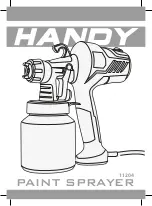
307010
9
Service
WARNING
To reduce the risk of serious injury,
whenever you are instructed to relieve
pressure, follow the
Pressure Relief
Procedure
on page 4.
SKIN INJECTION HAZARD
Swivel Repair
1.
Relieve the pressure
.
2.
Unscrew the swivel stud (21) from the gun. Re-
move the spring (22), glands (24†, 25†), and
packings (23†) from the swivel housing (26). See
Fig. 4.
3.
Clean all parts and inspect. The ball bearing in the
swivel stud should rotate freely. Replace any worn
or damaged parts.
NOTE:
Repair kit 207308 is available for the swivel.
Use all the parts in the kit for the best results.
4.
Install the spring (22), male gland (24†) and five
v-packings (23†) one at a time, make sure the lips
of the v-packings face into the housing. Install the
female gland (25†) and the swivel stud.
Needle Adjustment
WARNING
Proper adjustment of the needle is essential to
be sure the trigger safety latch makes the gun
inoperative when engaged. Improper adjustment
may allow the gun to be triggered, even with the
trigger safety latch engaged, resulting in serious
injury, including fluid injection and splashing in
the eyes or on the skin.
1.
Relieve the pressure
. Disconnect the hose.
2.
With the trigger safety latch (29) engaged,
squeeze the trigger. There should be about 0.125
in. (3.18 mm) free play at the end of the trigger.
See Fig. 6 on page 10.
3.
To adjust, remove the tip guard or nozzle exten-
sion. Release the safety latch. Squeeze the
trigger and loosen the locknut (4). Insert the
wrench (3) into the tip of the needle (10) and turn it
in or out until the proper free play is obtained.
Tighten the locknut (4).
4.
Install the tip guard. Start the system. Trigger the
gun and release; fluid flow should stop immediate-
ly. Now engage the trigger safety latch. Try to
trigger the gun; no fluid should flow.
If the gun
fails either test, relieve the pressure
and re-
adjust the needle.
Fig. 4
8124
22
24†
23†
25†
21
Fig. 5
8102
3
4
10
































